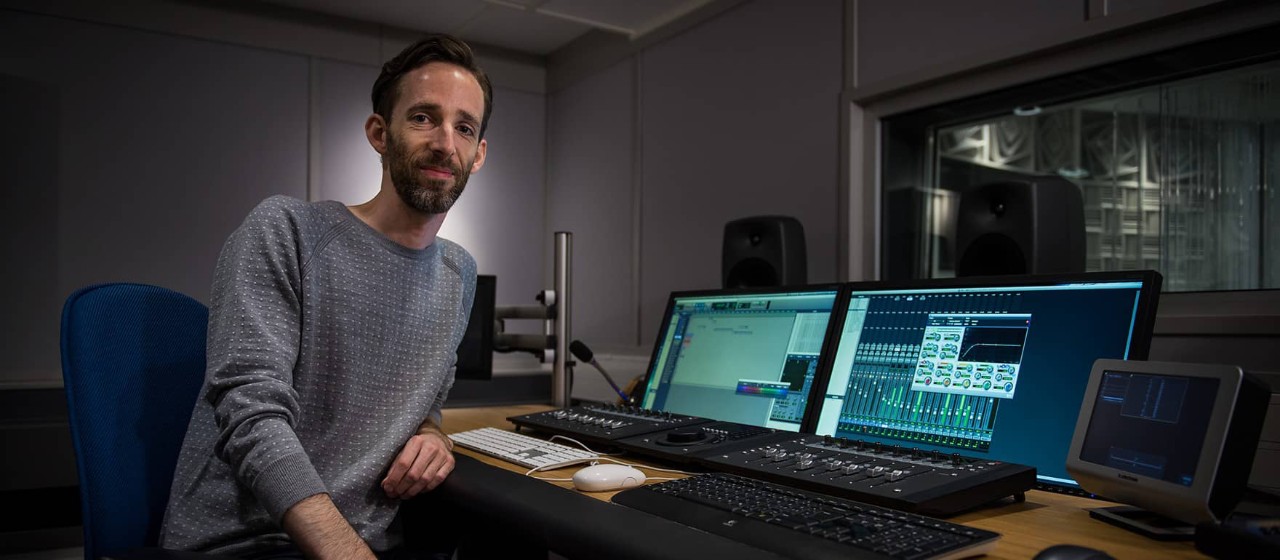
Meet Scania's in-house sound designer
10 JUNE 2019
Swonk. Pling. Tick-tick-tick. Meet the man responsible for creating sounds like these in Scania vehicles, Scania’s own in-house Sound Designer, Stefan Larsson.
Stefan Larsson’s interest in music and sound began at the age three years when he would sit and play with the keys of the family piano. Today, he has succeeded in combining his passion for sound with his work life, thanks to his job as a sound designer in a somewhat surprising field: heavy vehicles.
Creating a modern driver environment
We’re standing in Scania’s sound studio, an ultra-modern environment featuring acoustic dampening, ten or so listening posts, and top-of-the-line speakers on the walls. Behind the glass in the adjoining room, Larsson is sitting in at a control desk, adjusting the sliding switches on something that resembles a sound mixer in a music studio. But while his work tools include a keyboard and the music software program Pro Tools, Larsson’s workspace isn’t used for composing Taylor Swift’s latest hits.
“We use this space to create the synthetic sounds that form part of the modern driver environment,” explains Larsson, who is the only Scania employee to have the title of Sound Designer. “These can include different warning sounds, such as collision-warning or engine-failure tones, and interaction tones such as the sound made when the indicators are put on.”
Before he began his university studies, Larsson considered training as a sound engineer. However, he eventually elected to study industrial design engineering. His interest in sound and music was something he planned to pursue in his free time.
“But now I have a job that brings it all together,” he says with a smile. “My hobby is my job and everything has fallen into place.”
On the road development
Creating sounds for the driver environment is an extremely painstaking and time-consuming process. Different sounds are tested on drivers in the listening studio, in simulators, and in realistic driving situations, where it’s vital that sounds aren’t perceived as stressful. Each sound also has to interact with the vehicle’s other information systems and displays, something that forms a part of Larsson’s ongoing discussions with his 20 colleagues within the Driver-Vehicle Interaction group.
“Every sound must have a clear purpose,” he says. “If the driver doesn’t make exactly the right association, then it’s the wrong sound.”
Larsson adds, “You also need to remember that the driving situation is very different for a timber truck driver on a solitary forest road compared to the driver of a packed-to-the-brim city bus or a stressed delivery driver in a hectic city environment. For this reason, we need to constantly be thinking about different driving scenarios and balance the sounds so that there’s not too much irritating and stress-causing stimulus.”
Safety related sounds
Many of the sounds used in the driver environment are related to safety. But another important area for Larsson and his colleagues are sounds that help drivers to drive in a more energy-efficient manner.
“We want to support drivers in driving as fuel efficiently as possible, in every way we can, including with sound,” says Larsson. “So, there’s a link to future functions in Scania Driver Support and various existing and upcoming ‘reward systems’ that tell drivers when they have done something good. This is something that we’re going to see more and more of in future generations of heavy vehicles.”
However, synthetic sounds are not Larsson’s only area of responsibility. Together with his colleagues from the Acoustics department he is also involved in getting the correct Scania feel when the cabin door is closed, a switch is flicked, or a button is pressed.
New technologies – new challenges
“The sounds in a Scania should always correspond to what the product as a whole promises,” Larsson explains. “Everything needs to sound trustworthy, robust, clean and premium. This means that we, for instance, sometimes replace a certain material to get the right sound.”
Currently combustion engines and various forms of diesel are the dominant forces on the world’s roads. But with the arrival of new technologies, such as electric vehicles, come new challenges in terms of sound.
“Quiet electric vehicles are coming on a major scale and with these we’re working on introduced sounds to provide the driver with information on the vehicle. These include synthetic engine sound, so that drivers are able to hear when they’re accelerating. We’re also considering the sound they will make on the street in view of new legislation that will require a certain level of volume for safety reasons.”
Last question: what would be your dream assignment at Scania?
“I’d like to work with the whole sound-portfolio for the Scania brand – everything from how it sounds when you close a truck door to warning sounds in the cab, but also the kind of music played when you’re waiting in a telephone queue, how it sounds in our reception areas or when we have a stall at a trade fair. Hearing is a powerful sense that can drive many of our other senses. So, sound is of enormous importance when it comes to how a brand is perceived – something that more and more companies are beginning to discover.
Facts
Name: Stefan Larsson
Education: Master in Industrial Design Engineering from Luleå University of Technology, Audio production at SAE Institute, School of Audio Engineering.
Interests: “First and foremost music. In my free time, I help others to produce their music, but I also create my own music. I’m also interested in all types of culture, such as film and computer games.”